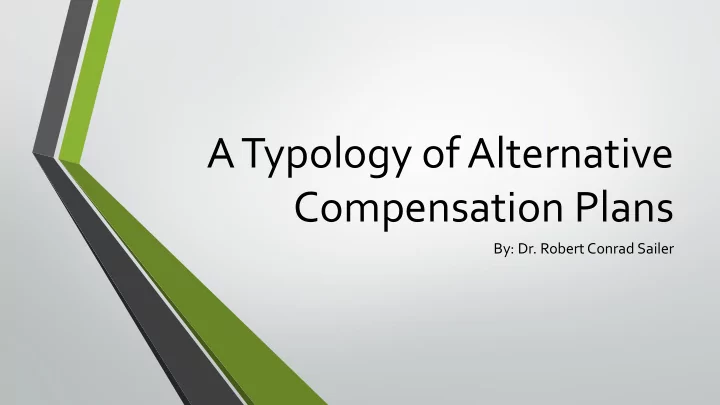

A Typology of Alternative Compensation Plans By: Dr. Robert Conrad Sailer
Format of Presentation • Very brief of biography of myself (30 seconds) • Introduction of the Research (Who, What, When, Where and Why) (5-minutes) • Data Presented by CESA, Geographic Category & Enrollment (15-minutes) • Conclusion/Recommendations for Implementing an Alternative Plan (15-minutes) • Tools from the study (5-minutes) • Q & A (5-minutes)
Brief Bio
Introduction to the Study • Teacher compensation stable -- last 60 years • Act 10 • Unrest, Uncertainty and Teacher Shortages The Beginning of a New Era
Need for this Study • No current research on alternative plans currently in use in WI
Purpose of the Study • To create a typology of compensation plans.
Research Question What are specific components of alternative teacher compensation plans that are in effect in Wisconsin public school districts as of the fall of 2015.
Dellutri Identified the Following Alternative Models
Research Created Two More Plans • Consumer-Price Indexed (CPI) – Compensation increases based solely on CPI • Sustainable (SP) – No formal plan, compensation is at the discretion of the superintendent
Districts with Step & Lane Plans by Geographical Category 160 140 120 100 80 60 40 20 0 Rural Town Suburban City # of Schools who Responded (%) # of Schools who responded they use Step & Lane
Participating Districts by Student Enrollment
Plans by CESA 20 18 16 14 12 10 8 6 4 2 0 1 2 3 4 5 6 7 8 9 10 11 12 Career Ladder CPI Hybrid Knowledge and Skills-Based Sustainable Pay for Performance Step & Lane Merit Pay
Plans by Geographic Category
Plans by District Enrollment
Wisconsin Districts’ Plans Type n Career ladder 14 Consumer-price index 9 Hybrid 63 Knowledge & skills-based 20 Merit pay 1 Pay for performance 3 Step & lane 94 Sustainable 15
Outcomes • A typology of compensation plans.
Breakdown of Components
Recommendations to Implement an Alternative Plan • Educate Staff on Components • Defining Components • Financial Viability • Winners and Losers
Future Research • What components or conditions did school leaders find made the compensation plan difficult to maintain? • Implementation process of the plan • Review of this study five or ten years later • How does the incorporation of EE vary from one district to the next? continued…
• Research the perceptions of community members, teachers, administrators, or school board members with respect to one or more alternative compensation plans. What do stakeholders view as the strengths or weaknesses of the plan? • The impact of an alternative compensation plan on teacher attraction and retention • Survey teachers and administrators that have had an alternative compensation plan in place for at least three years. The future is endless…
The size and scope of alternative plans is growing.
Until local and state politics can stabilize the ever-turbulent field of education, in part created by Act 10, the conversation of alternative plans will only continue to grow.
Questions?
Recommend
More recommend